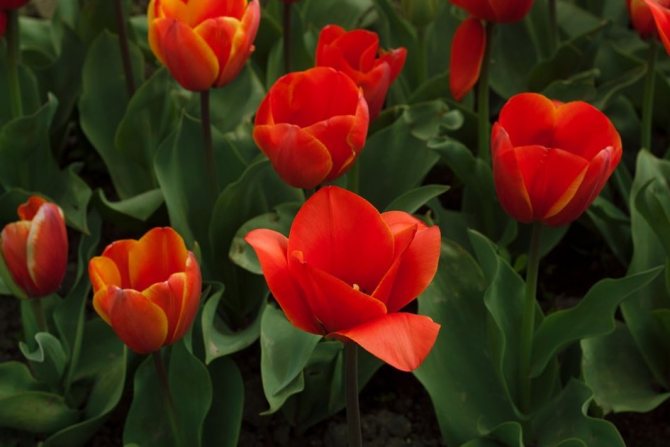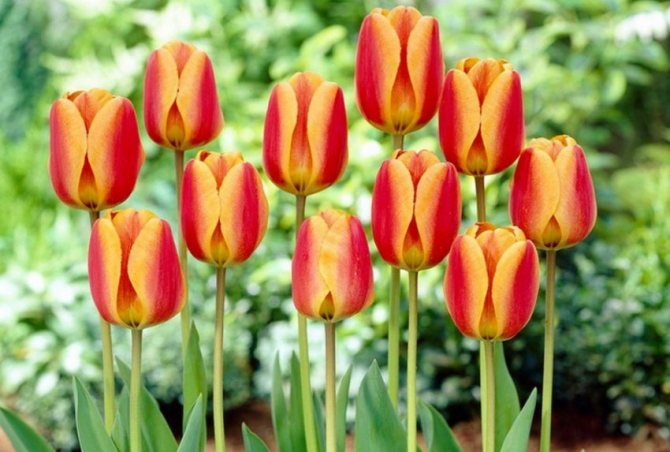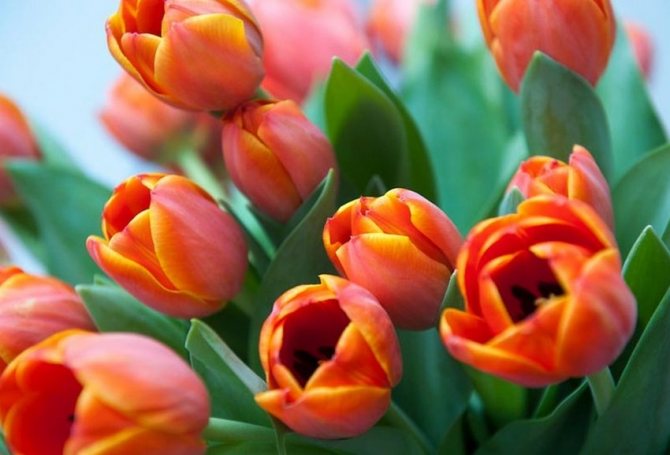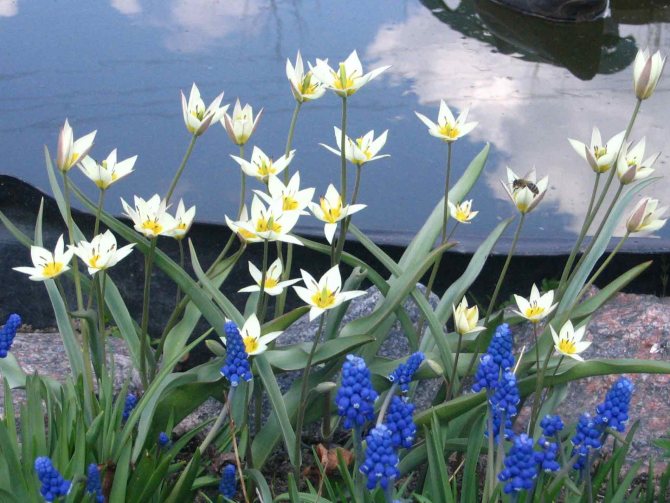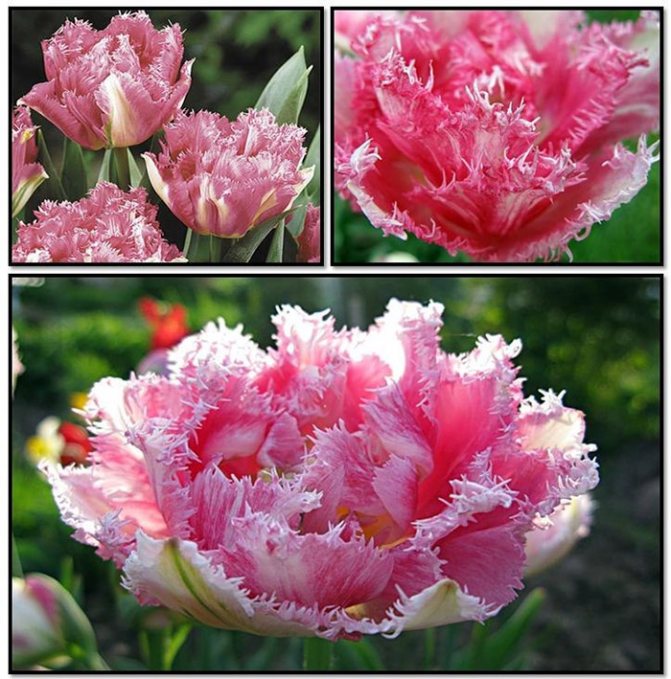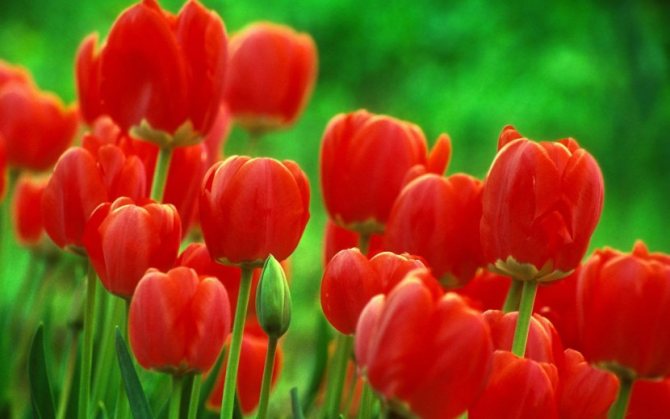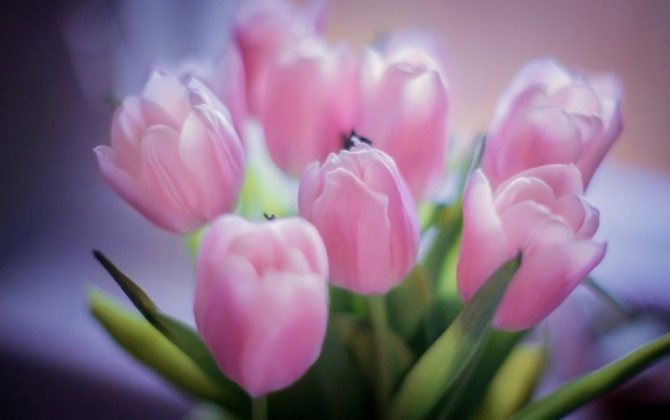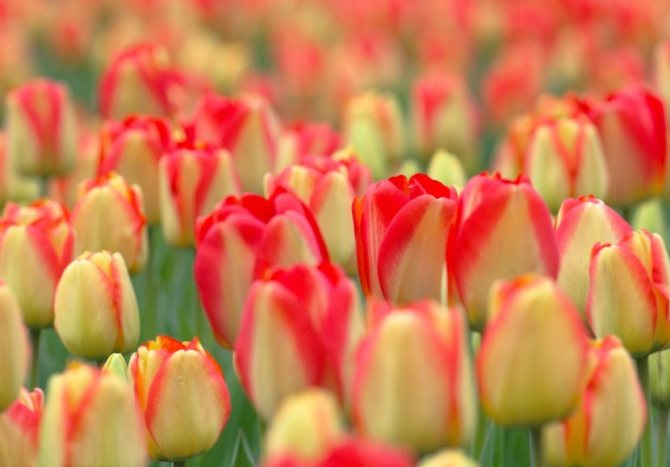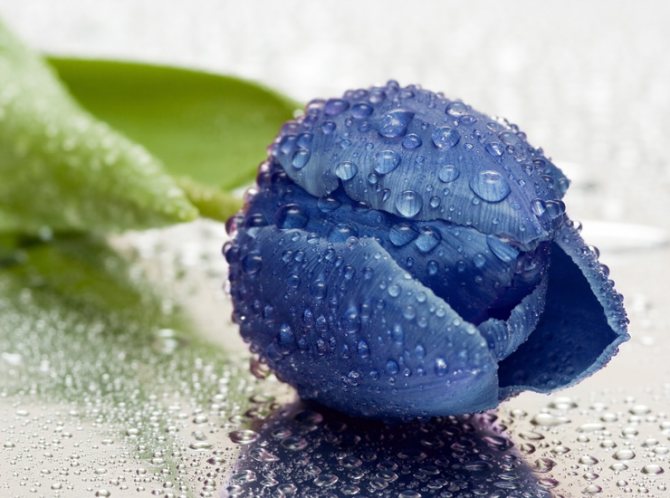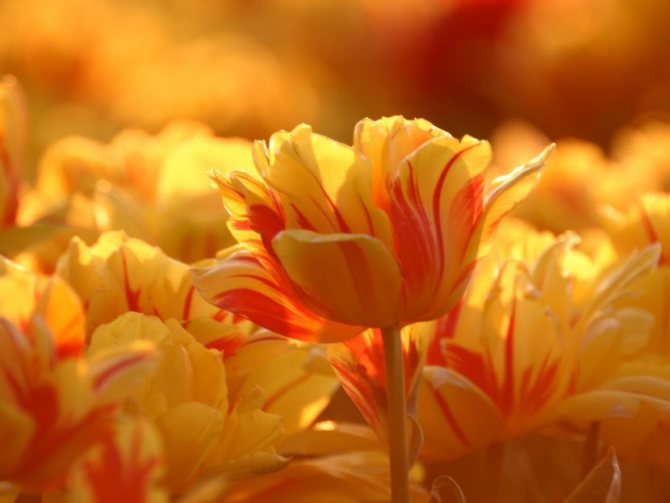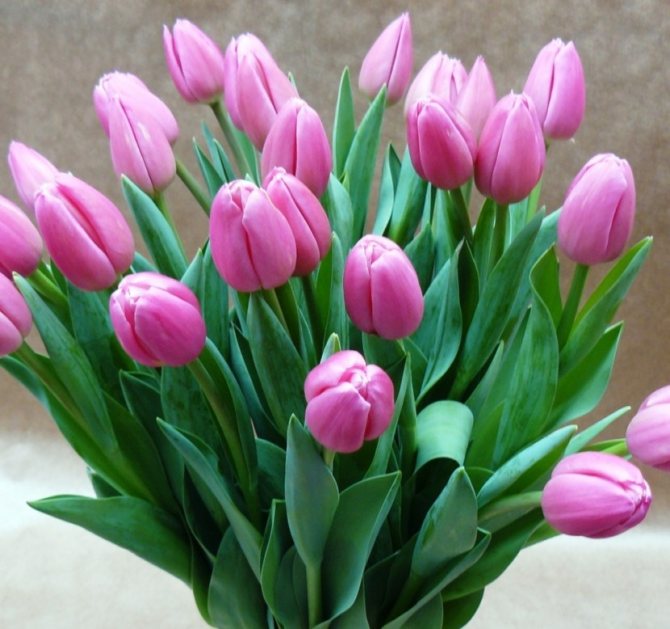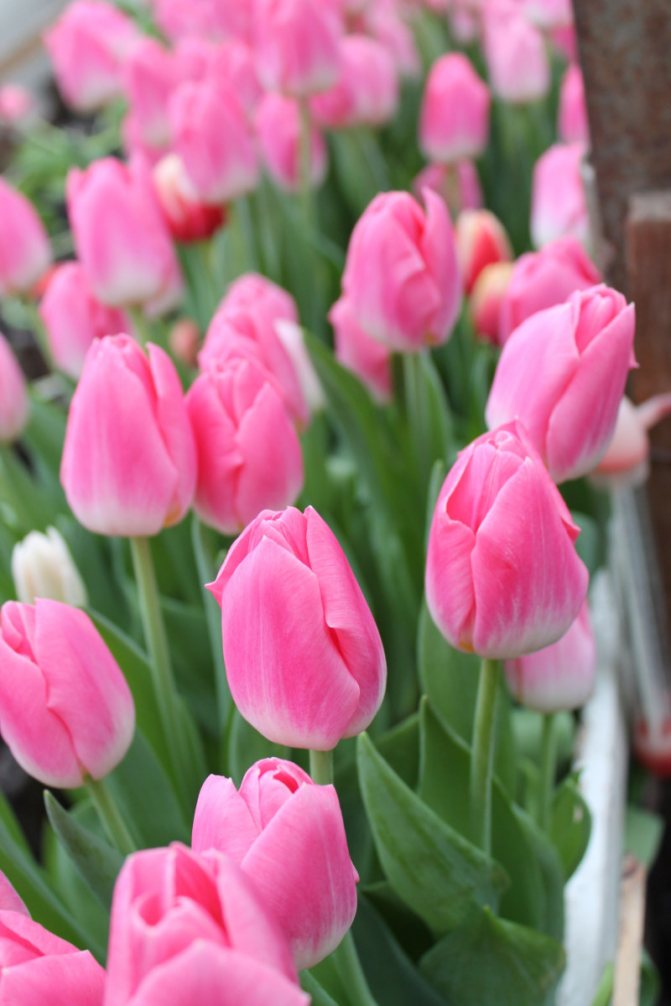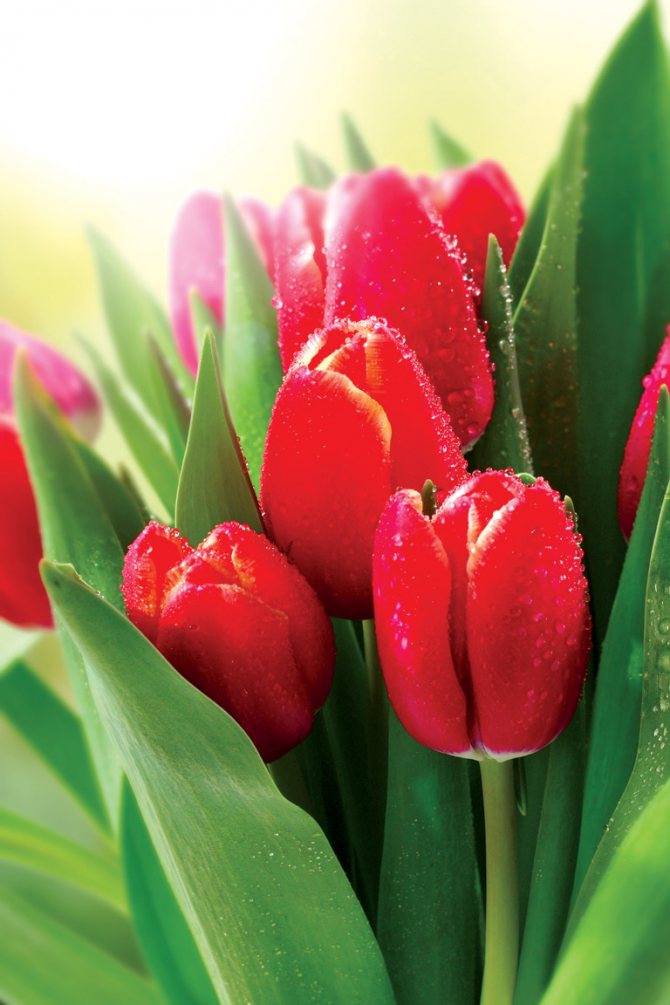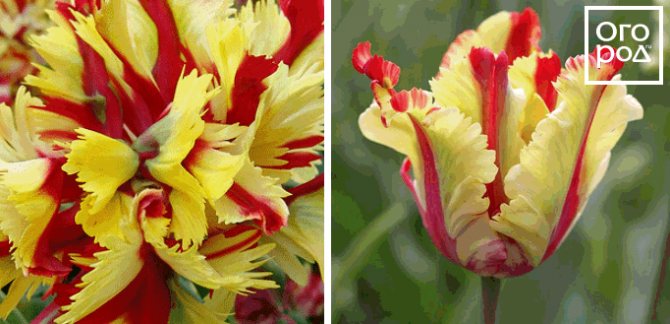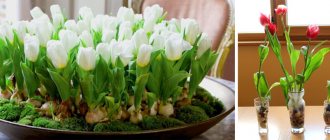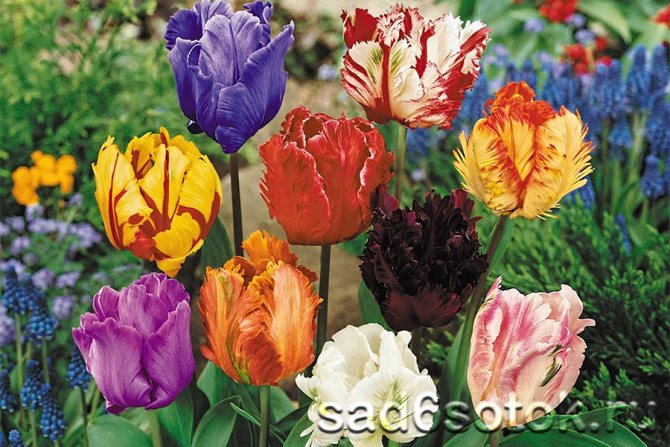
Tulips of different color shades
Of all the ornamental bulbous plants, tulips have the widest selection variety, exquisite shape and rich palette of colors - from delicate matte shades to catchy colorful tones. The long flowering period allows you to enjoy the festival of colors from early spring, when botanical varieties break out, until early summer, when magnificent terry and parrot varieties take over the baton.
Tulip features


The height of a tulip varies from 10 to 100 cm. The accessory roots grow from the bottom of the bulbs, and they represent the root system of this plant. Every year these roots die off. In young bulbs, hollow stolons appear - these are lateral shoots that can grow both vertically downward and sideways. A daughter bulb appears at the bottom of these shoots. The erect stem has a cylindrical shape. On the surface of lanceolate-elongated alternately located leaves there is a coating of wax, which is why their color acquires a greenish-bluish tint. At the very top is the smallest leaf plate, called the flag leaf. And at the bottom is the largest leaf. Typically, a plant has 1 flower. But there are species that grow from 3 to 5 and even more flowers. They have the correct shape. The perianth includes 6 leaves, while there are the same number of stamens with elongated anthers. The most common color of the flower is red, the rarer is yellow and very rare is white. Varietal tulips can be painted in a wide variety of colors. So, there are purple, yellow, almost black, red, snow-white, violet. There are also varieties in which flowers can be painted in several different color shades, while there are a lot of variations in their combinations. Flowers can also have very different shapes, namely: goblet, oval, star-shaped, cup-shaped, lily-shaped, peony-shaped, fringed, etc. The size of the flowers also depends on the variety. So, there are flowers about 12 centimeters long, while their diameter can vary from 3 to 10 centimeters, and during full disclosure it reaches 20 centimeters. The opening of the buds occurs at a time when the sun is shining in the sky, in the evening they close. In cloudy weather, the flowers do not open at all. After the plant has faded, a fruit is formed, which is a box with 3 sides. It has triangular brownish-yellow flat seeds inside.
Class attributes
This group includes varieties with fast growth, large and tall glasses.
Several distinctive features are included in the description:
- on average, the height of the peduncle is 70 cm;
- flowers are large with a rectangular bottom;
- all varieties are medium-flowering - bloom in the last decade of April and fade in mid-May;
- plants have increased immunity against the viral sore of variegated leaves;
- universal application - grown both for cutting and for decorating personal plots.
Some varieties are on the verge of extinction due to the difficulty in growing. But most of them are successfully grown in many regions of our country.
Growing features


In order to successfully grow such extraordinarily beautiful flowers, it is imperative to learn how to properly care for them. At the same time, the rules for caring for tulips are not very complicated, and even a florist with very little experience can cope with their cultivation.
Fundamental rules
- During the intensive growth of the flower, fertilizer must be applied to the soil 3 times.
- You can understand what kind of fertilizer a plant lacks by its appearance. So, if the leaves have become less wide and are not able to maintain an upright position, then the tulip needs a nitrogen-containing fertilizer. The blue that appears along the edge of the foliage means that the plants lack potassium, as well as phosphorus.
- Diseased tulips must be pulled out of the soil along with the bulbs. To disinfect the soil, you need to pour a freshly boiled solution of potassium manganese into the formed hole.
- Treat the soil in the immediate vicinity of the flower carefully. The fact is that it is very easy to damage the leaf plates or roots of the plant, and then the bulb can lose its nutrition.
- In the event that you want to enjoy the view of a contentedly large flower next year, as well as prevent the onion from breaking up into several small ones, you must definitely pick the wilted flower before the fruit appears.
- The dug out bulbs are dried in a shaded place, as they react extremely negatively to the direct rays of the sun.
- The introduction of fresh manure into the soil can lead to rotting of the bulbs, as well as the appearance of fungal diseases.
- If it is cold in winter and little snow falls, then it is necessary to mulch the soil surface using peat, sawdust, humus or straw.
- If you cut a flower from a plant, then you must leave at least 2 leaves. In this case, the bulb will be able to receive normal nutrition for full development.
- When choosing a plot of soil for planting, tulips should be planted in a place where they have not been grown for at least 3 years.
Where grows
Tulips of the Darwin's hybrids group are grown throughout the territory of our country, since they have good resistance to cold and disease.
They look beautiful both in single and group plantings, in flower beds, in mixborders, rockeries, on alpine slides and ridges.
Often they are combined with ornamental deciduous plants, coniferous shrubs, not planted in the foreground.
Dense tulip stripes are an excellent decoration for alleys and city parks.
Planting tulips outdoors
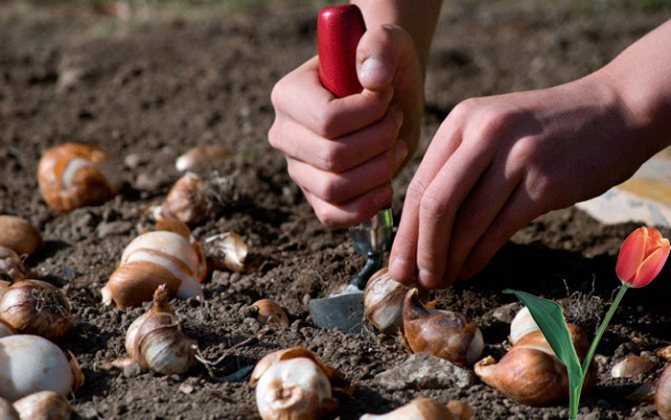

What time should you plant
For the normal development of the plant, it is necessary to plant them in the soil in a timely manner. So, it should be remembered that the planting of the bulbs in the soil must be carried out in the autumn, and at the same time do not forget that it will take at least 3-4 weeks for them to take root normally. If the bulbs are planted later, then in spring they will grow and develop more slowly than it should be, and they will also form very small bulbs. They will also not bloom so effectively. If they are planted too early in the soil, the bulbs can germinate. In this case, the very first frosts will destroy the plants. The optimal time for planting tulips is recommended to be calculated from the soil temperature. So, it needs to be measured at a depth of about 10-12 centimeters. If it is 10 degrees, then you can safely land. As a rule, this time falls in the middle of September.
Planting bulbs in spring
Florists with considerable experience assure that in the spring it is possible to plant the bulbs if you did not have time to do this in the autumn months. However, you will definitely not wait for abundant flowering this year. It will be good if only a few specimens bloom. Before planting the bulbs, they need to be put on the refrigerator shelf overnight, and then processed in a weak solution of potassium manganese (keep for about 30 minutes).The preparation of the beds should be done after the snow cover disappears. So, with the help of a pitchfork, it is necessary to dig up the ground and make grooves. For large bulbs, the distance between the grooves is 25-30 centimeters, and for children - from 10 to 15 centimeters. Before planting the bulbs, water the grooves with a freshly boiled potassium manganese solution.
When choosing a place for tulips, you should take into account that it must be sunny and protected from strong gusts of wind. The soil should be well drained, slightly alkaline or neutral. Sandy loam soil is ideal, in which in the spring it is necessary to add rotted compost, as well as wood ash (200 g is taken per 1 m2). If the soil is very heavy, it can be improved. To do this, you need to add compost, river sand and nutrient-rich loose soil to it. To enhance drainage, it is necessary to pour a three-centimeter layer of washed coarse sand on the bottom of the prepared grooves during planting. Large bulbs should be buried in the ground to a depth of 10 to 15 centimeters, and small ones (children) - from 5 to 7 centimeters. The bulbs should be slightly pressed into the ground, and then sprinkled with soil and hardened with a rake. Mulching with peat will help prevent soil cracking.
Autumn planting


In autumn, it is important to plant tulips correctly and provide them with the necessary care. The fact is that very soon the winter period will come and how the plants overwinter, and how effectively they will bloom in the spring, directly depends on how successfully you worked in the fall. Before planting tulips, it is necessary to thoroughly examine their bulbs. So, those that have signs of any disease or damage should be destroyed. Experienced florists recommend planting according to varieties. In this case, caring for the plants will not be so difficult, and it is easier to dig up the bulbs. Before planting directly, the bulb must be soaked for half an hour or an hour in a 5% solution of potassium manganese. They need to be planted in the same way as in the spring. In light soil, the bulb must be planted to a depth equal to its 3 diameters, and in heavier soil - 2. It is imperative to mulch the surface of the soil. Peat, straw, dry foliage, and sawdust are perfect for this.
Black
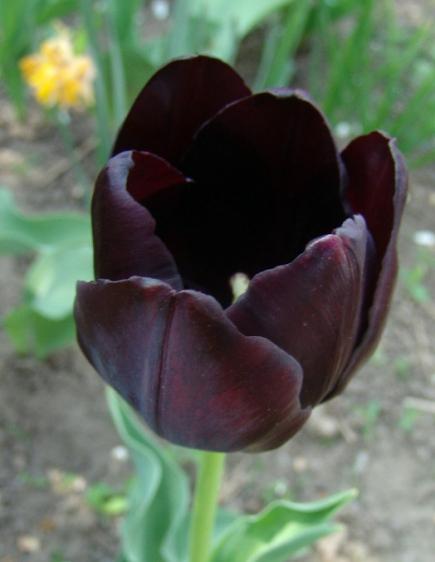

Black has different meanings. Many associate it with grief, loss. On the other hand, it is the color of strictness and commitment in business. In the 60s of the last century, the film "Black Tulip" was released with the brilliant Alain Delon in the title role. He was in the image of the French Robin Hood, and the black tulip was his sign and symbol of the revolutionary struggle.
The dark colors of tulips, and in particular black, were bred by order of the Negro representatives of Haarlem and were supposed to emphasize the beauty of the black Dutch. However, the meaning of such flowers is associated not with beauty and not with the struggle for freedom, but with unrequited love. Having presented such a bouquet, in the language of flowers, you hint at your feelings without due reciprocity.
Sometimes black tulips are given when they want to show that feelings are so strong that death is not terrible either. True, some associate these flowers with material wealth and prosperity in business. Therefore, such a gift does not always mean feelings. Perhaps the one who gives it just wishes you success and wealth. The Black Prince variety is the most demanded in our markets.
Tulip care
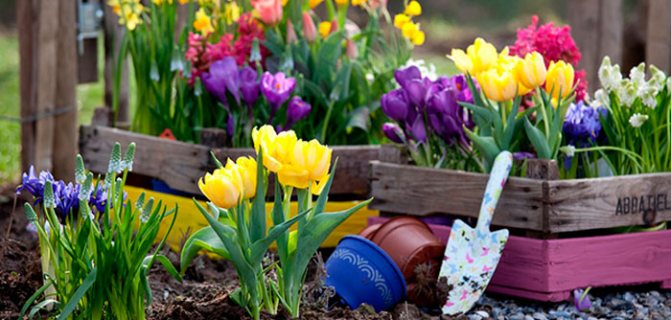

It is necessary to take care of such flowers from the beginning of spring. After the shoots appear, the plantings should be carefully examined. Those bulbs that did not sprout must be carefully dug up and destroyed in order to prevent the spread of the disease to other plants. The tulip is very fond of moisture, but its roots are quite short and therefore the flower is not able to take water from deep layers of the soil.Therefore, it is very important to water the tulips on time. How often and abundantly the plants should be watered directly depends on the composition of the soil. But it should be borne in mind that during the formation of buds and flowering, they should be watered abundantly and systematically. After the plant has faded, it is watered abundantly and systematically for another half month. When watering, water should seep into the soil to the entire depth of the root system. In this regard, 10–40 liters of water should be poured per 1 square meter. When watering, try to prevent liquid from getting on the surface of the leaves, as this may cause a burn.
Top dressing
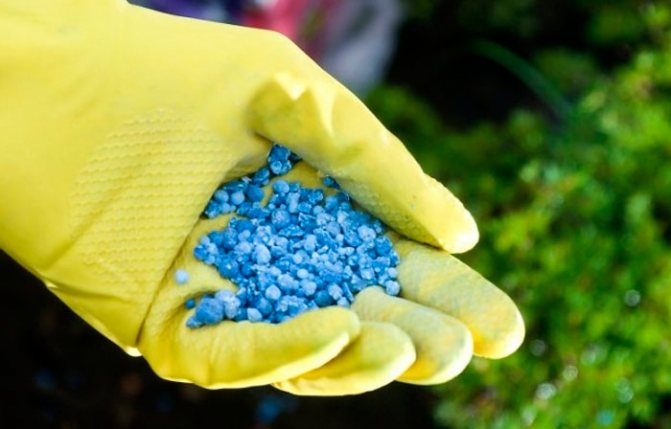

It is recommended to feed the plants with fertilizer solutions. If you like dry fertilizers, then before scattering them over the surface of the soil, you need to ventilate the tulip leaves. So, if fertilizer gets on a wet area of the leaf plate, then as a result of this, a burn may form. After the dry fertilizer is distributed over the area, the soil should be thoroughly watered. Only in this case, nutrients can penetrate into the soil and be absorbed by the tulip root system. The first time the plants should be fed in early spring, after the sprouts appear. At this time, you can carry out top dressing with dry fertilizer. You just need to spread it evenly, and then water the soil. A mixture of phosphorus, nitrogen and potassium (2: 2: 1) is suitable as a fertilizer. 1 square meter will take 50 g of this fertilizer. The second feeding is carried out at the beginning of budding. This time it is recommended to use a nutrient solution containing 1 part nitrogen, 2 parts phosphorus and the same amount of potassium. For 1 square meter, you need 30–35 g of solution. For the third time, fertilizers are applied to the soil immediately after the end of flowering. This time, phosphorus and potassium are taken in equal parts, and nitrogen is not used. 1 square meter will take from 30 to 35 g of solution. In order for the plants to grow daughter bulbs more intensively, a small amount of zinc and boron should be added to the solution.
Loosening the soil and removing weeds
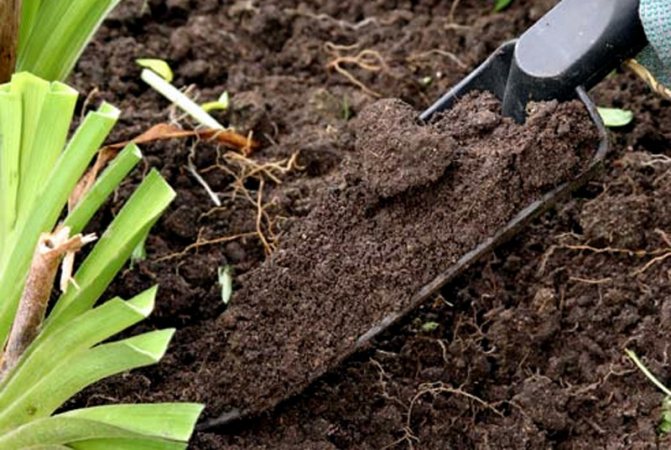

Loosening the soil and removing weeds should be systematic. It is recommended to carry out such a procedure after watering, since at this time it is easiest to pull out the weeds. It should be remembered that weeds take a lot of nutrients from the soil, thus depleting the soil. In this regard, try to delete them in a timely manner. If the soil is systematically loosened, this will slow down the process of moisture evaporation, and will also lead to the death of weeds. To weed and loosen much less often, it is recommended to distribute a uniform layer of mulch over the soil surface.
Do not forget to pick off fading flowers in a timely manner. In this case, tulips will not waste their energy on the growth and development of seeds, but the mass of bulbs will increase.
Transplant features


If you dig up the bulbs every year, examine them, sort them, etch them to reduce the risk of disease, then all the same it will not be able to nullify the negative impact of monoculture. There are 2 ways out: the first is to completely change the topsoil, the second is to transplant the plant to a new site. The most convenient way is the second. You can not transplant only tulips from 13 to 15 class. However, they will need a transplant after 3 or 4 years.
Reproduction methods


It can be propagated by seeds and with the help of bulbs. As a rule, only specialists (breeders) use seeds for reproduction, and that's all, because this kind of flowers are not able to preserve the varietal characteristics of the parent plant. Sowing is carried out in a greenhouse or in open soil. They are grown in one place without transplanting for 2-3 years, while the plants must be protected from frost in the winter. After that, ripe bulbs need to be dug up and stored. The landing should be carried out in the autumn. The first flowering of such plants is observed only at 5-6 years of age.However, it should be borne in mind that the first years of the flowers will not be very effective. Only at 8–12 years of age will the tulip bloom very effectively.
Experienced growers recommend propagating tulips exclusively with bulbs. An important feature of such plants is that after flowering ends, the parent bulb dies off, and it is replaced by a developing daughter with children. A lot of factors can influence the number of children formed, and the main one is environmental. It happens that not 1 large, but 2 smaller replacing bulbs are formed. At the same time, peduncles may grow in children after a few years. If you want to avoid the gradual degeneration of plants, then plant only onion-toppers in the soil, the diameter of which should be at least 12 centimeters. Such plants retain all the necessary varietal characteristics. Small onions are recommended for indoor distillation. In this case, the children should be grown to the required size and only after that they should be planted on an area with plants.
Pests and diseases


The most serious disease is the variegated virus. Finding out that a flower is infected is quite simple. So, if non-variegated varieties have characteristic stripes, streaks and spots on the petals and leaves, then the plant is infected. It is impossible to cure such a disease. In this regard, you need to take a responsible approach to the acquisition of planting material, and do this only from reliable sellers. Also, when cutting tulips, the knife blade must be disinfected after each bush, since this virus can be transmitted along with the sap of the plant. Infected tulips must be dug out of the ground along with an earthen clod and destroyed (burned). In this case, a very strong solution of manganese potassium must be poured into the hole.
Such a plant is susceptible to the August disease, the development of which is facilitated by the tobacco necrosis virus. You can find out that a tulip is infected by a twisted shoot and a flower disfigured by stripes; specks of dark color also appear on the bulbs. The infected flower must be destroyed. To do this, it is dug directly with an earthen lump, and a very strong solution should be poured into the resulting hole, for the preparation of which 3 grams of boric acid and 10 grams of manganese potassium are taken per liter of water. A hot solution should be poured into the hole. Or, instead of a solution, pour wood ash into the hole. For prevention purposes, healthy tulips are treated with a solution of foundationol.
Also, the plant is susceptible to fungal diseases. So, it can become infected with root, wet, soft, gray, white or botrytous rot. Plants are especially susceptible to such diseases during a rainy spring. Regardless of the cause of the disease, preventive measures are the same: the land must be well drained and the plants must be properly cared for. When the bulbs are dug up in the summer, it is recommended to sow plants that can produce phytoncides in this area of the soil, for example: calendula, nasturtium, marigolds or mustard. You should also spill the area with a fungicide solution (2 g of substance per liter of water).
Lilac scoops, snails, mouse-like rodents, bears, onion root mites, slugs can settle on the plant. Get rid of the onion mite in the following way. The dug out bulbs must be immersed in hot (from 35 to 40 degrees) water and held for about 5 minutes. In the case when tulips become infected during the period of intensive growth, they are treated with a 2% solution of rogor or keltan. In the absence of the desired result, diseased flowers must be destroyed. When you dig up the bulbs, you need to plant radishes, tomatoes or tagetas in this area of the soil, as they are resistant to these pests.You can get rid of the purple scoop by shedding mothballs on the foliage. On the site you need to lay out pieces of material, boards, pieces of slate and plywood, etc. Under them slugs, bears, snails will crawl under them in the daytime. You will have to systematically collect and destroy them. Dig a glass jar into the soil and fill it with water (not to the top). Bears fall into this trap and do not get out. Mousetraps will help with rodents, or you can process the bulbs before planting with iron red lead.
White
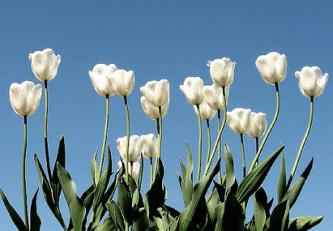

Each tulip color has many shades. And only the white one. Since ancient times, it has been associated with purity and sincerity. A bouquet of white tulips no longer hints, but speaks openly about the purity and seriousness of your feelings. White tulips also help to ask for forgiveness. Agree, there are situations when it is difficult to do it with words - either pride gets in the way, or false shame. There is no need to despair. A bouquet of pristine and delicate snow-white tulips will do it for you, make the one you give flowers to smile. And then the words will be found. The most famous varieties are Angel Wees with a large bud, peony Cardinal Minjenty, fringed Honey Moon.
Tulips after flowering
Care of a faded plant


- Apply phosphate-potassium fertilizer.
- Remove wilted flowers along with ovaries.
- Do not prune the stems.
- The faded plant is watered for another half a month, and then watering is gradually reduced and completely stopped.
- When the leaves and stem wilt, the bulb should be dug.
- What time should you dig the onion
Only a few varieties of tulips, whose flowers are red in color, can be left in the soil for the summer. So, if the bulbs are not dug up, then the flowers will become smaller, and the stem will be shorter and thinner. The fact is that every year after flowering, the mother's bulb pushes the children upward, and itself sinks into the soil. Therefore, the plant without transplanting the next year will have small flowers, because the children are blooming, while the parent bulb remains "buried". In this regard, after the foliage is completely dry and when the stem becomes very flexible, you need to dig out the bulb with a bayonet shovel.
Pink
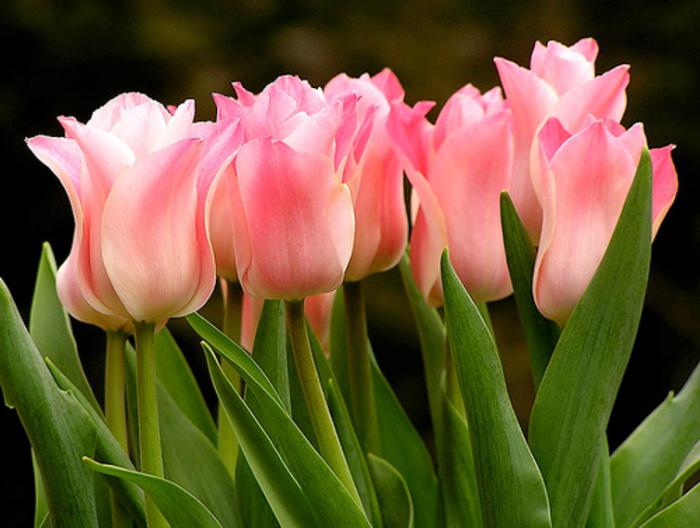

Pink has always been considered the color of tenderness. The meaning of the color of pink tulips in your bouquet is a hint of tender and quivering feelings, about which you do not dare to say aloud yet. Also, pink is youth and her belief that all obstacles are surmountable. Pink tulips in a bouquet say that there is no burning passion in love yet, but there are wonderful feelings filled with dreams and hopes.
Among the varieties of pink tulips, Eipricot Beauty is the most common. Its flower petals are so delicate that they seem fragile. Angelica tulips are very interesting, their doubleness is similar to peonies. Among the fringed ones, New Look and Bellflower are popular.
Storing tulip bulbs
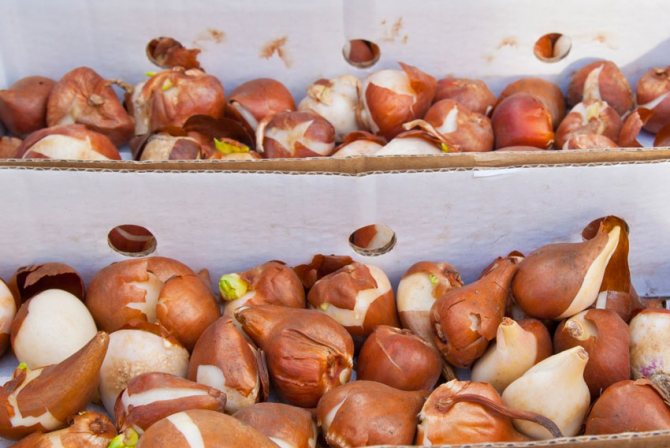

The bulbs removed from the ground should be thoroughly rinsed under running water and put on for 30 minutes. in 3-4% solution of karbofos, you can take them for 10 minutes. immerse in water with a temperature of 50 degrees. Place the bulbs in a dry, well-ventilated, dark place with a temperature of 25 to 30 degrees in 1 layer. The bulbs dried for 3-5 days are removed for storage.
Preparation for storage: remove old roots and scales from the bulbs, separate the babies that come off without effort. Distribute by size. Sprinkle the bulbs in 1 layer into trellised boxes, and then move to a well-ventilated place with diffused lighting, for example, in the attic or in the barn. Do not cover them, because children may die, as the bulbs release ethylene. Until the beginning of autumn, the temperature should be maintained at about 20 degrees, later it can be reduced to 17 degrees. Inspect the bulbs systematically every 7 days. Destroy soft bulbs, as well as those that have light yellow or whitish spots (signs of decay).Before planting in autumn, process the planting material with a potassium manganese solution.
Yellow
Some are sure that yellow tulips hint at cooling of feelings and inevitable separation. The song of Igor Nikolaev, sung by Natasha Koroleva, once again confirmed and unwittingly consolidated this opinion, because the couple broke up. But yellow tulips are flowers not only of sadness, but also of sunlight, which warms all living things with its warmth. A bouquet of yellow tulips will bring comfort and joy of a bright day to your home, as if several sunny bunnies settled in your room. And yellow is also a harbinger of happiness.
Giving a sunny bouquet to our loved ones, we wish them well-being and prosperity in the language of flowers. There is a good legend about happiness, as if it chose a house in a yellow tulip and did not reveal it to anyone. Only to one little boy, who ran up to the flower with a sincere childish smile, the flower opened its petals. The most favorite varieties are Golden Apeldoorn, Mon Amour peony, Laverock and Hamilton fringed tulips.
Main types and varieties with photos
Most of the species cultivated by humans are related to a species called Tulipa gesneriana. And in the wild, you can meet the following species: Tulipa sylvestris (forest tulip), Tulipa biebersteiniana (Bieberstein tulip), Tulipa biflora (two-flowered tulip), as well as Tulipa greigii, Tulipa pubescens, Tulipa eichleri, etc.
Dutch growers in November 1981 made a new (last) classification of tulips. Also, a register was compiled, which included 10 thousand varieties, divided into 4 groups, as well as 15 classes. This classification is accepted by all unconditionally.
1st group. Early flowering
1st grade - Simple early


They have a small height, strong peduncle from 25 to 40 centimeters. Yellow or red goblet or cupped flower. Varieties: Demeter, Golden Olga, Golden Harvest.
2nd class - Early terry
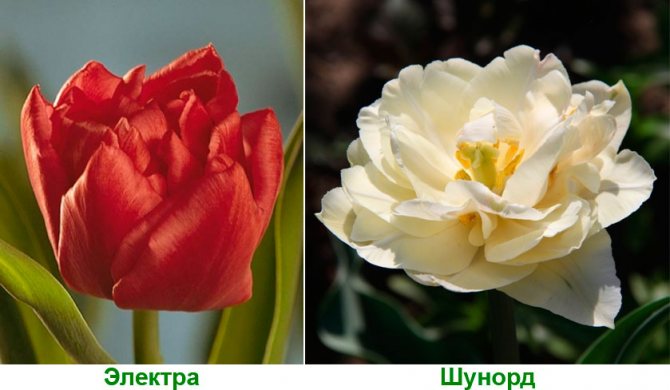

They reach a height of 25 to 35 centimeters, double flowers can be yellow or red. Their diameter after full disclosure is 10 centimeters. Long flowering. Varieties: "Electra", "Shunord", "Madame Testu".
2nd group. Mid-flowering
3rd class - Triumph
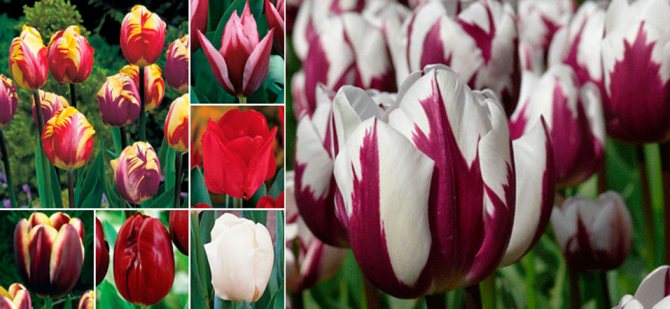

The height of the peduncles is from 40 to 70 centimeters. Large goblet-shaped flowers can be painted in different shades from dark purple to pure white. Varieties: Crater, Golden Eddy, Snowstar.
4th grade - Darwin hybrids
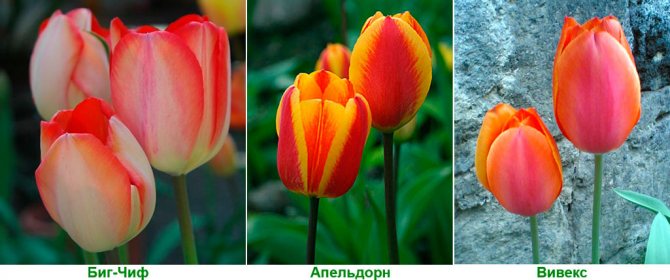

Peduncle height from 60 to 80 centimeters. The diameter of the flowers is more than 10 centimeters. Painted in bright red or other shades of this color (there are two colors). They tolerate frosts in the spring and are not susceptible to variegation virus. Varieties: "Big Chief", "Apeldoorn", "Vivex".
3rd group. Late blooming
5th grade - Late simple
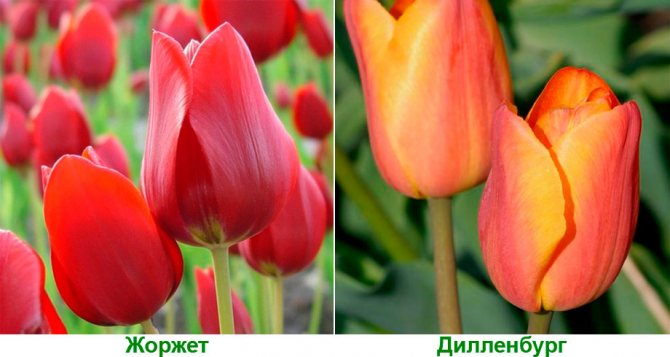

Strong bushes reach a height of 60 to 75 centimeters. Large goblet-shaped flowers have obtuse petals and a square-shaped base. The color is from black to white, from burgundy to pinkish, there are also two-tone. They reproduce easily. Varieties: Georgette, Dillenburg, Bacchus.
6th grade. Lily-colored


In height, the peduncle reaches from 50 to 60 centimeters. The flowers are glass-shaped and have pointed petals that are folded back. The color is different. Varieties: Red Shine, White Triumphant, Gisella.
7th grade - Fringed
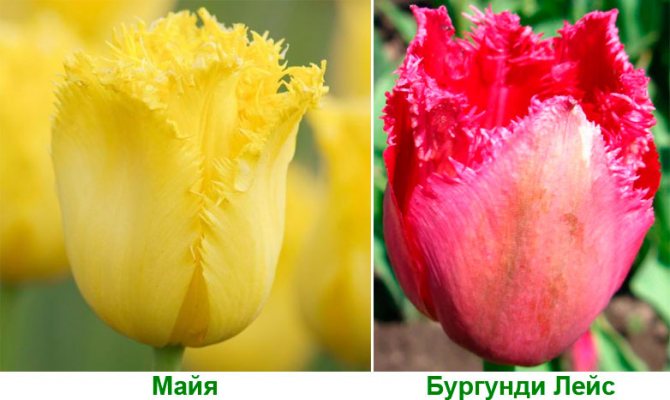

A needle-like fringe runs along the edge of the petals. They reach a height of 50 to 80 centimeters. Can be colored from purple and dark chocolate to white. The size and shape of the flowers are varied. Varieties: "Exotic", "Maya", "Burgundy Lace".
8th grade - Greens
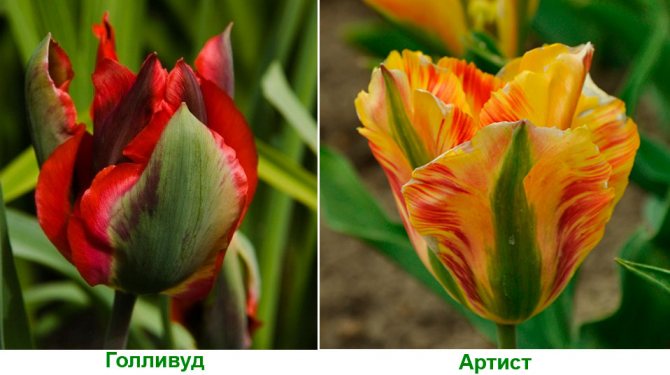

During the entire flowering, there are greenish spots on the backs of the petals. They reach a height of 30-60 centimeters. Narrow sheet plates. The length of the flowers is from 6 to 10 centimeters. Varieties: "Samurai", "Hollywood", "Artist".
9th grade - Rembrandt


A small class that includes variegated varieties. Large flowers have the shape of a glass and their length is 7-9 centimeters. Streaks and spots are scattered on yellow, red or white petals. The peduncle reaches a height of 40 to 70 centimeters. Varieties: Black Boy, Montgomery, Pierrette.
10th grade. Parrot


The most exotic ones. The petals are heavily cut along the edge and are similar to the wing of a bird. When fully expanded, the diameter of the flower is sometimes 20 centimeters. The height of the bush varies from 40 to 65 centimeters. Color from red-black to white. Varieties: "Discovery", "Black Parrot", "Fantasy".
11th grade - Late terry


Peony flowers are densely double. The height of the peduncles is from 45 to 60 centimeters. Flowering later, the size exceeds the double varieties. The color is different, there are two-colored. Varieties: Livingston, Eros, Nice.
4th group. Botanical and species
12th grade - Kaufman


Very early flowering. Bushes reach a height of 15 to 25 centimeters. Elongated, large flowers, after opening, are star-shaped. The color is different, but bicolor varieties are more common. The foliage has spots or stripes of a purple hue. Varieties: "Diamond", "Lady Rose Orange Boy", "Crown".
13th grade - Foster


Quite large plants. The length of the elongated flowers is 15 centimeters. In height, the peduncle reaches from 30 to 50 centimeters. The color is rich red and orange-red, there are varieties of pink, as well as yellow. On the surface of the slightly wavy fleshy leaves, streaks of purple color are sometimes found. Varieties: "Zombie", "Patient", "Copenhagen".
14th grade - Greiga


The height of the bush is only 20 to 30 centimeters. Quite large flowers have a wide base. The petals are slightly bent back. Color - different shades of red, there are two colors. There is a speck on the surface of the leaves. Varieties: Yellow Down, Zampa, Plaisir.
Red
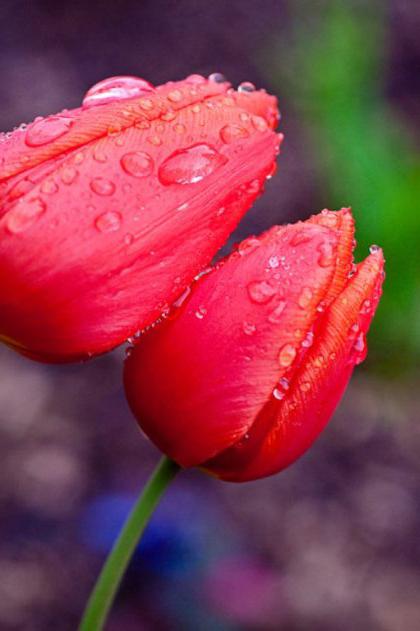

This color is the most common. Bright, eye-catching buds can decorate any flower garden. It is believed that the first tulips were exactly red. They appeared at the moment when Prince Farhat, madly in love with his bride Shirin, crashed on the rocks. The evil people lied to the prince that his Shirin had died. The unfortunate man could not survive this news, spurred his horse and rushed straight to the sharp stones. Tulips bloomed exactly where the drops of poor Farhat's blood fell. Since then, the red tulip has stood for fiery and passionate love.
There are a great many varieties of red tulips. There are simple ones, there are terry ones, there are fringed petals. In the Red Emperor variety, the flower fully opens its buds. And Garden Spot remains half-open. The red color has many shades: from scarlet to dark red, almost burgundy. Most often in our flower beds you can find the varieties Parade, Madame Curie, Boston. Recently, tulips Edda, Redwing and others, whose petals have the finest fringe, have been popular.
Groups and classes - general description
In this section, we will simply show what the classification looks like, and then we will analyze it in detail. So, tulips are divided according to the following principle.
Group 1. Early flowering.
- Class 1. Simple.
- Class 2. Terry.
Group 2. Medium flowering.
- Class 3. Triumph
- Class 4. Hybrids of Darwin.
Group 3. Late flowering.
- Class 5. Simple.
- Class 6. Lily flowers.
- Class 7. Fringed.
- Class 8. Green-colored.
- Class 9. Rembrandt.
- Class 10. Parrots.
- Class 11. Terry.
Group 4. Types of tulips and their hybrids.
- Class 12. Kaufman.
- Class 13. Foster.
- Class 14. Greig.
- Class 15. Wild.
This is what the classification looks like at the moment. There are many different tulip varieties in each group and class. Let's get acquainted with some of them.
Varieties for the Moscow region
The climatic conditions of the Moscow region and the surrounding regions are not suitable for growing all types of tulips. Classes such as Darwin's hybrids, Triumph, Greig, Kaufman adapt well to conditions.For them, open places are chosen, sheltered from the wind. Of the varieties in the middle lane, such as Apeldoorn, Parade, Floradale are popular.
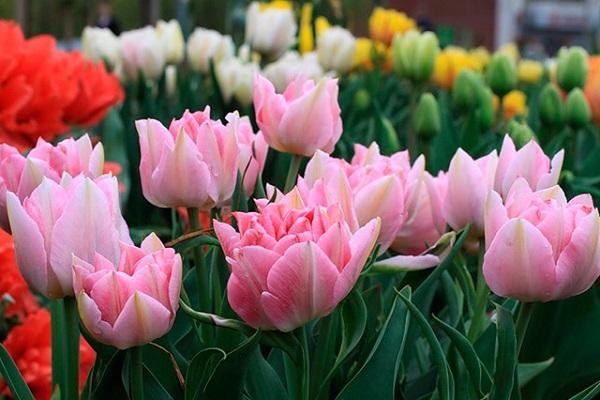

Tulip: characteristic of a plant for children
Tulips are incredibly beautiful flowers and are quite unpretentious in care and cultivation, which is why they are deservedly popular in countries with a temperate climate. The structure of the flower is very simple, but depending on the type of plant, the shape and size of the petals, leaves and stem can change.
There are innumerable varieties of such a popular flower, 114 main species and a huge number of hybrids are distinguished. Conventionally, tulips can be divided into the following subspecies:
- Simple - they resemble a glass in shape, have one bud, a stem approximately 30 cm high, and is considered short. Late types of simple tulips have large flowers and reach a height of 75 cm
- Terry species have large and heavy flowers, and the stem does not grow higher than 25 cm.Often such flowers have a very bright color
- Fringed - unique in that it has a fringe on the edges of the petals, and therefore an incredibly beautiful type of tulips. The stem height reaches 80 cm.
- The lily-colored look is refined and really resembles a lily, but at the same time it has a very bright color, they can also have several colors
- Parrot tulips are distinguished by an amazing shape, which resembles the feathers of a parrot, and are also characterized by a very variegated color, ranging from a combination of light shades to a combination of pink and black
- Green tulips get their name from the green back of the petals.
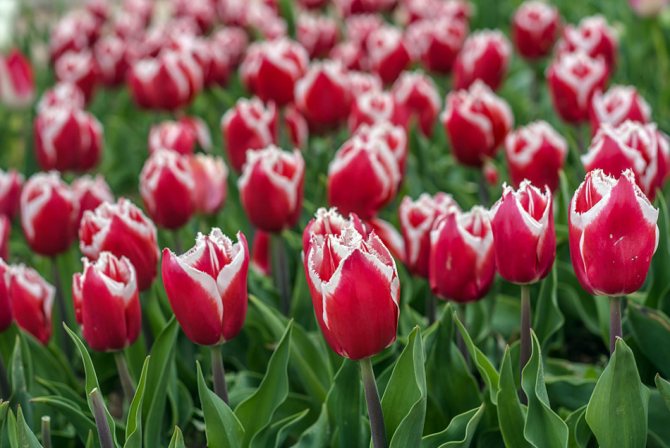

Tulips there are a large number of varieties
Tulip is a perennial plant that blooms by the beginning of spring, but with the arrival of summer, the leaves fall off. And the flower can be renewed annually for 5-6 years, of course, depending on the type of plant. Often, tulip hybrids have a life activity of no more than 26 months.
Today tulips are used not only for decoration, but also have found application for the beneficial properties of the flower in cosmetology and medicine. Tulip oil is suitable for treating rashes, and in folk medicine, tulip is used to treat cardiovascular diseases. The petals, leaves and bulbs of the flower are considered edible and are widely sought after in the culinary arts around the world.
Variegated
It is impossible to enumerate all the colors of tulips and all the combinations of shades that occur on the petals of these flowers at the same time. Red with yellow, white with pink, red with white fringe and thousands of others turn tulips into unusually bright and variegated flowers. It is believed that the person who gives such a bouquet intends to emphasize the beauty of the eyes of the person to whom the bouquet is intended. If you do not think about the eyes, colorful tulips, charming with fantastic beauty strokes and dots on the petals, incredibly cheer up, give smiles and bring many pleasant moments into relationships.
Simple late
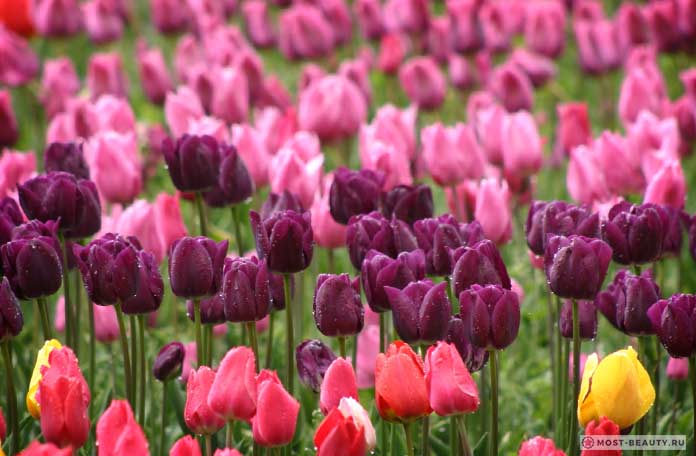

This category includes up to 50 varieties (high stem and medium bud) that were bred by English breeders in the 18th century. They are distinguished by late flowering at the end of May. Unusual buds with rounded petals have a multifaceted color - from snow-white to almost black.
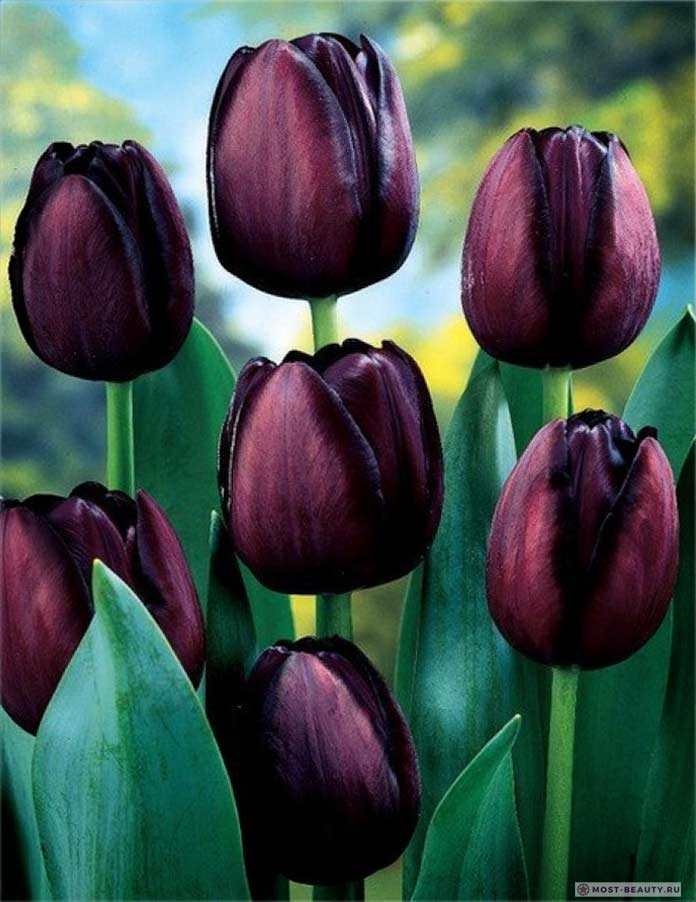

It is in this category that the most charming varieties "Queen of the Night" and "Red Georgette" belong. The latter impresses with an almost pomegranate shade of petals. The incredible purple color of the "Queen of the Night" flowers is so dark that they are even referred to as black tulips. This is one of the most extravagant and enchanting varieties.
Chato
These classic double tulips can compete with peonies or roses in the beauty of their buds. Their bright crimson flowers are visible even from afar. Chato tulips are suitable for both gardening and cutting, and they also produce excellent forcing.
| Purpose | Class | Stem height | Bloom |
| Terry late | 45-60 cm | April May | |
Content
- Listen to the article
- Description
- Growing features
- Planting tulips in the ground When to plant
- Planting in spring
- Planting in autumn
- How to care
- Post-flowering care
Blue and blue
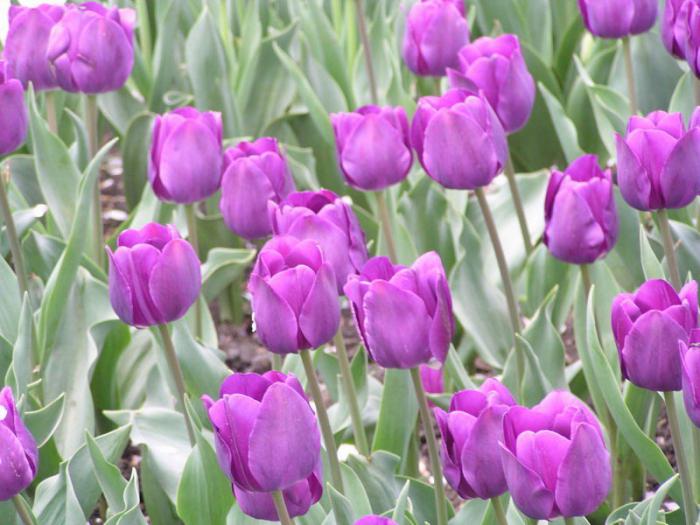

What color tulips are never found in nature? The answer is unambiguous: blue and blue shades, because the chromosomes of these colors do not have the so-called "blue" dolphinidin gene. But blue and blue tulips still exist, although they are very rare. They were brought out by the enterprising Dutch. However, in order to grow an unusual tulip from a ready-made bulb, you need to try.
Such tulips in a bouquet is a desire to amaze the one who is given flowers. The giver seems to be talking about such a strength of his feelings that he will be able to get the impossible. Also, blue is a harbinger of great luck and success. There is a legend that blue tulips bloom high in the mountains for only a few days, and those who find them will be lucky in life.
Esperanto (Esperanto)
The charming and sophisticated flowers of Esperanto tulips boast not only dense bright red buds with green veins and silvery streaks, but also ruffled petals. The flowers do not stay on the stems for too long, but what a scent they exude! Tulips of this variety are good in a flower bed and in a cut.
| Purpose | Class | Stem height | Bloom |
| Greens | 30-40 cm | April May | |
Rembrandt


They are so impressive with the original sophistication and variegated color of the petals that the illusion arises that the great artist himself once splashed paints from his palette onto these flowers and gave them such incredible charm.
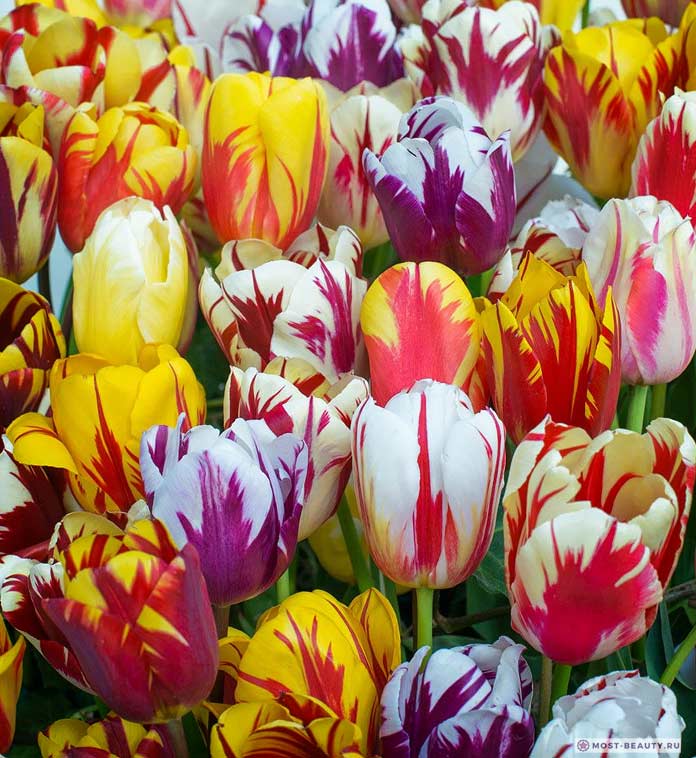

Their colorful bloom can be admired from mid-May. These are the rarest and smallest varieties of tulips, distinguished by their unpretentiousness and special decorative effect. Popular pink and white Cordell Hull and creamy purple Insulinde.
Eastern flower in the vastness of Europe
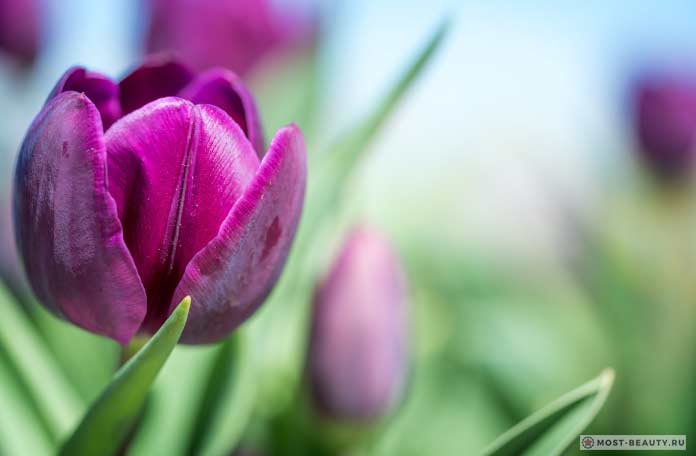

Many people mistakenly believe that these spring flowers come from Holland, but in reality they were brought to Europe from Turkey, and there - from Iran, where they were considered a symbol of peace and harmony. The fiery flower of the East first came to the European expanses in the 16th century, and initially only aristocrats could acquire it. You could even buy a house for his bulbs.
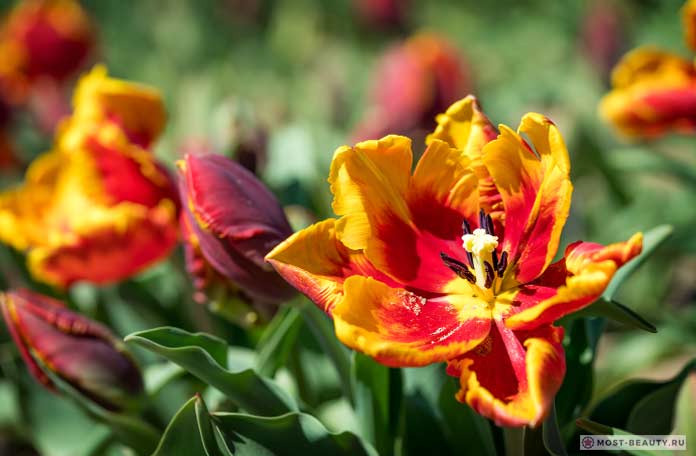

Now there are more than 3000 varieties of tulips, differing in a wide variety of color shades. The most common are reds and yellows, but the color scheme of these colors is fantastically diverse.
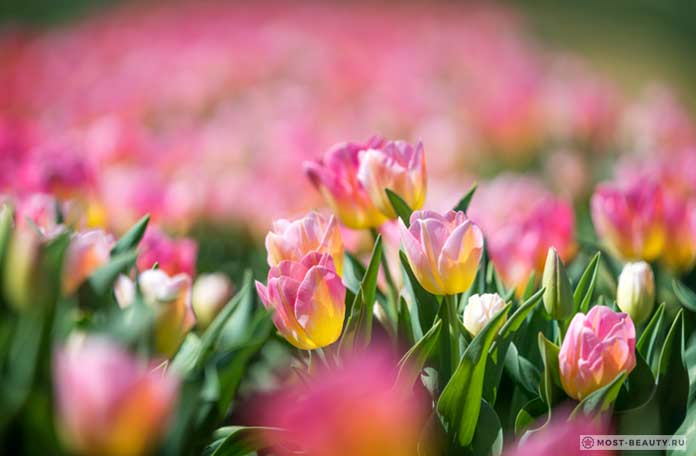

Pink, white, purple, cream, lilac, blue and even black flowers are amazing. Also impressive is the originality of the cup, which can be in the shape of a glass, resemble a blossoming peony or have needle-like edges.
Late terry
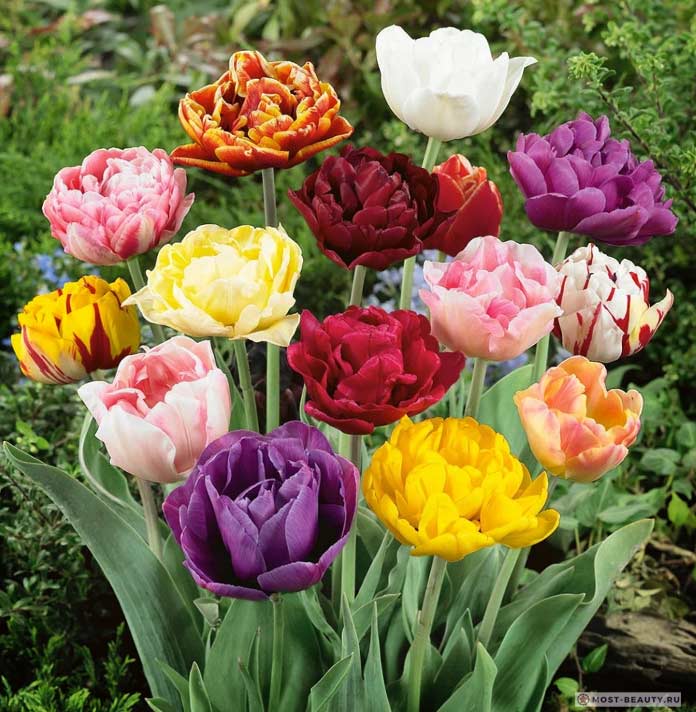

Known since the 17th century, the variety is distinguished by colorful flowers resembling peonies. Its color can be either innocently white or incredibly bright and colorful.
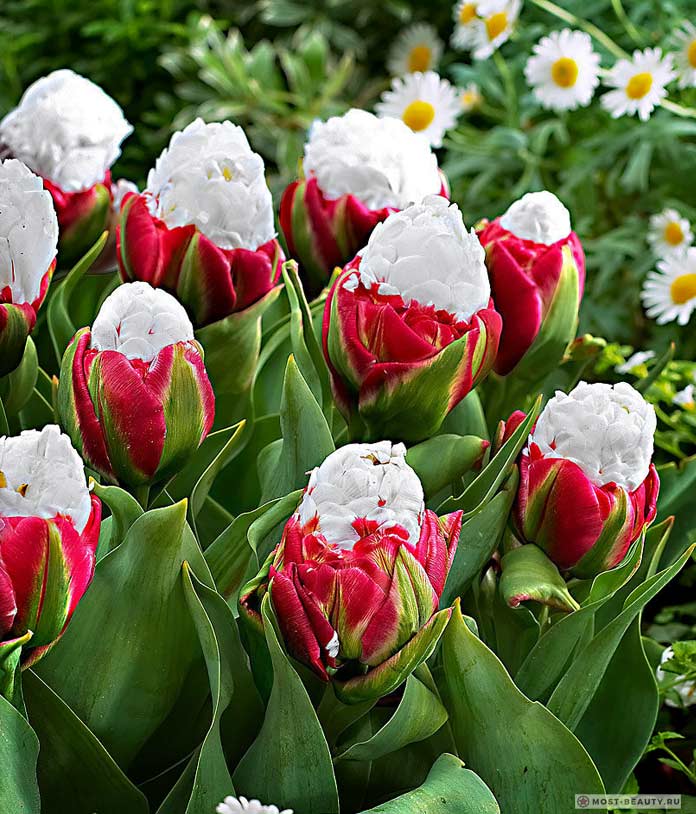

These flowers have too heavy buds that can break easily in strong winds and rains. Among them, the most exotic variety is Plombir with snow-white petals surrounded by pink ones, which is similar to ice cream and is considered particularly demanding to care for.
Destiny (Destiny)
This variety belongs to the Parrot tulips, which are considered one of the most interesting. See for yourself how unusual and even exotic they look. Destiny tulips have very large buds and bloom quite late: in the second half of May. But the expectation of their flowering is justified. Flowers are best for decorating a flower garden.
| Purpose | Class | Stem height | Bloom |
| Parrot | 40-65 cm | May | |
Flaming Parrot
Flaming Parrot tulips are very unusual.Their corrugated bright yellow flowers with no less bright red stripes and streaks stay on plants for up to 3 weeks. The petals surprise not only with their bold color, but also with their shape. They look like the wings of some unknown birds. It is not for nothing that these tulips belong to the Parrot class. Flaming Parrot is suitable for decorating flower beds and making bouquets.
| |||
| Purpose | Class | Stem height | Bloom |
| Parrot | 50-70 cm | At the end of May | |
Brooklyn (Brooklyn)
These green tulips are very unusual not only in color, but also in the shape of the bud. The densely doubled flower ends with a white cap, which gives this plant a cosmic look. It is advisable to tie up Brooklyn tulips because they bend easily under the weight of their chic buds. These flowers look great in the garden and may also be suitable for cutting.
| Purpose | Class | Stem height | Bloom |
| Terry late | 35-50 cm | April May | |
Dutch novelties
New plant species appear every year. A representative of the Triumph class, the lilac Canberra flower with shiny petals is perfect in shape. The hybrid has many advantages. It is resistant to disease, it stands for a long time in the cut. And how beautiful is the white Albatross, which is perfect for forcing.
The fringed Super Siesta looks bright with its crimson petals and white border. A medium-sized plant will beautify any area.
The flowers of the Whispering Dream are similar to pink lilies. Glasses of wonderful flowers up to 7-8 centimeters long rise on the stems of medium height.
The most popular varieties of simple early tulips
Class 1... Simple early tulips.
Cultivated since the end of the 17th century. One of the first to bloom outdoors. The shape of the flower is cupped or broad-cupped. The color is predominantly warm colors (red, yellow, pink). The peduncle is low. Suitable for distillation from February. In the class, 5.7% of the total assortment.
Table "The most popular varieties of simple early tulips":
| Variety name | Breeder, year of registration | Plant height, cm | Flower color | Flowering period |
| Bestseller | K. van Kimmenade, 1959 | 45 | Copper red | FROM |
| Christmas Marvel | L. Shoal, 1954 | 40 | Cherry pink | R |
| Mary Christmas | Th. and W.B. Reus, 1972 | 40 | Purplish red with a lighter border | R |
| Flair | Jacques van den Verg, 1978 | 40 | Red with a wide buttercup yellow border | R |
| Apricot Beauty | K. van Kimmenade, 1953 | 40 | Apricot salmon | FROM |
| Hermitage | J. de Wit and Sons, 1986 | 40 | Jasper red with tangerine red border | FROM |
These photos show varieties of simple early tulips, the names of which are given in the table:
Sensual Touch
Fringed tulips, such as the Sensual Touch cultivar, have a delicate needle-like fringe at the tips of the petals. It is so small that it creates the illusion of frost on the lush yellow-orange buds. These tulips are suitable for decorating gardens and are suitable for cutting.
| Purpose | Class | Stem height | Bloom |
| Fringed | 45-50 cm | The end of May | |



